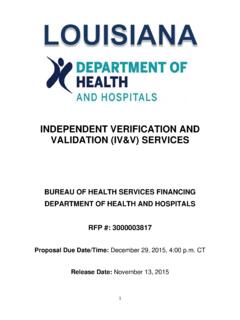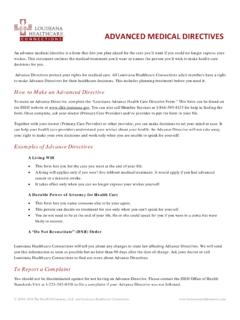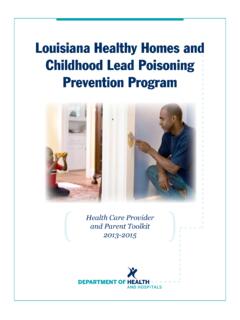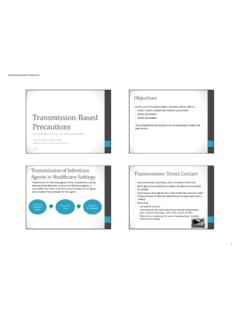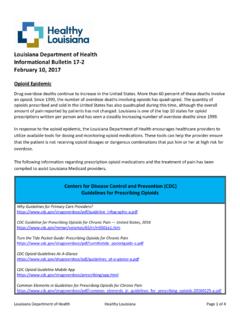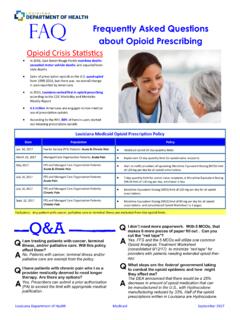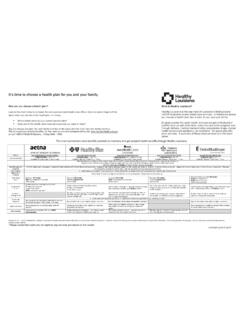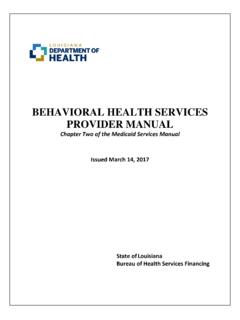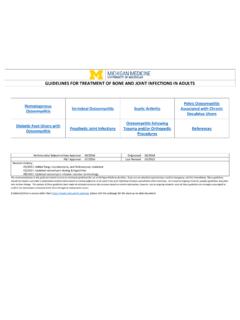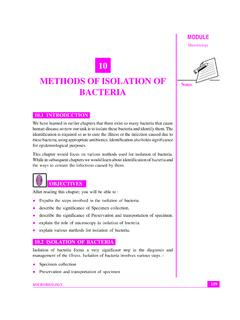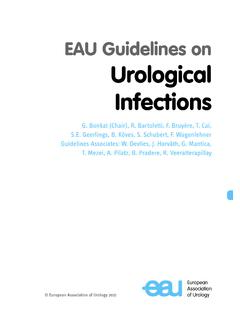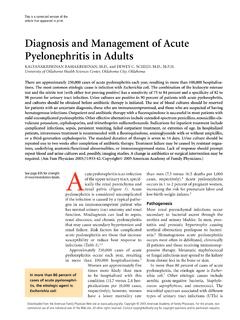Transcription of MRSA Guidelines for Long Term Care Facilities (LTCF)
1 Page 1 of 11 Updated 2/8/2008 MRSA Guidelines for Long Term Care Facilities (LTCF) 1. Introduction The term methicillin-resistant Staphylococcus aureus (MRSA) refers to those strains of Staphylo-coccus aureus bacteria that have acquired resistance to the antibiotics methicillin or oxacillin. The in-cidence of MRSA has increased in health care Facilities in the United States since the mid-1970s and in the community since the mid 1980s. Approaches to the control of MRSA vary widely, primarily be-cause studies establishing the efficacy of specific infection control measures are lacking.
2 This guideline recommends the most widely used approaches to the control of MRSA in long term care Facilities , including nursing homes, chronic care and rehabilitation hospitals, extended care Facilities , assisted living Facilities , etc. Once MRSA has become firmly established in a facility, it is rarely eliminated. A variety of control measures have been reported and many of these reports cite beneficial results. It should be emphasized, however, that the efficacy of most measures used for surveillance, prevention and control of MRSA has not been established in controlled studies.
3 As a result, recommendations in this guideline are based on general infection control principles, on review of published articles dealing with the epidemiology and control of MRSA in hospitals and long term care Facilities and on national Guidelines ( Guidelines for Isolation Precautions, Preventing transmission of infectious agents in health care settings - Centers for Disease Control and Prevention (CDC) 2007; Management of Multi-drug resistant organisms in health care settings, - CDC 2006). 2. Basic information on MRSA Emergence of MRSA In the past, staphylococcal infections were easily treated with a short course of penicillin with very few complications.
4 Unfortunately, staphylococcal infections quickly became resistant to penicillin. Methi-cillin, along with other drugs, was developed in the 1950s to address the problem. However, by the 1960s, methicillin-resistant strains of staphylococcal began to appear. By the 1980s, Staphylococcus aureus infections resistant to methicillin and methicillin-related drugs were becoming highly prevalent. These resistant infections were labeled methicillin-resistant Staphylococcus aureus (MRSA). Histori-cally, genetic analyses of MRSA isolated from patients in hospitals worldwide revealed that a rela-tively small number of MRSA strains have unique qualities that facilitate their transmission from pa-Infectious Disease Epidemiology Section Office of Public Health, Louisiana Dept of Health & Hospitals 800-256-2748 (24 hr number)
5 Page 2 of 11 tient to patient within healthcare Facilities over wide geographic areas, explaining the dramatic in-creases in hospital acquired infections caused by MRSA in the 1980s and early 1990s. Fortunately, there are still different classes of antibiotics that can be used to control these infections, but resistance continues to spread to our newer drugs and threatens to exhaust our supply of effective treatments if practices are not put into place to stop irresponsible antibiotic use.
6 Starting in the late 1980s several studies have pointed to the emergence of new strains of community-associated MRSA (CA-MRSA in contrast to hospital-associated MRSA or HA-MRSA). The emer-gence of new epidemic strains of MRSA in the community, among patients without established MRSA risk factors, may present new challenges to MRSA control in healthcare settings. To date, most MRSA strains isolated from patients with CA-MRSA infections have been microbiologically distinct from those endemic in healthcare settings, suggesting that some of these strains may have arisen de novo in the community via acquisition of methicillin resistance genes by established methicillin-susceptible S.
7 Aureus (MSSA) strains. Two pulsed-field types, termed USA300 and USA400 according to a typing scheme established at CDC, have accounted for the majority of CA-MRSA infections characterized in the United States, whereas pulsed-field types USA100 and USA200 are the predominant genotypes endemic in healthcare settings. USA300 and USA400 genotypes almost always carry type IV of the staphylococcal chromosomal cassette (SCC) mec, the mobile genetic element that carries the mecA methicillin-resistance gene. This genetic cassette is smaller than types I through III, the types typically found in healthcare associated MRSA strains, and is hypothesized to be more easily transferable be-tween S.
8 Aureus strains. Virulence of MRSA Many older hospital-associated MRSA strains tend to be simple colonizers, they are present on the skin or mucosa and cause no infection, no disease. Others have the same pathogenic potential than regular No difference was found in animal lethality, in production of extracellular enzymes or toxins, or in intraleukocyte survival in these hospital-associated strains. CA-MRSA strains may be more virulent: In 1999 CDC reported 4 cases of lethal MRSA infections among children (12 months to 13 years from Minnesota and N. Dakota) who clearly had community acquired infections (hepatic abscess, brain abscess and necrotizing pneumonia).
9 Unlike HA-MRSA strains, CA-MRSA stains produce superantigens (SEB and SEC, but not TSST-1). Superantigen pro-duction is a recently described virulence factor of both staphylococci and streptococci and is important because superantigen production by these microbes in immunologically na ve persons can cause toxic shock syndrome. Reservoirs of MRSA In Louisiana, it is estimated that: 30% of the general population are carriers of Staphylococci 1% of the low risk population are carriers of MRSA 5%-20% of high risk populations are carriers of MRSA (patients with multiple hospitalizations, residents of long term Facilities , chronically ill patients, inmates in detention Facilities , etc.)
10 This means that out of a 4,500,000 population, 1,500,000 are carriers of S. aureus and 45,000 are carri-ers of MRSA. Page 3 of 11 Colonized and infected residents serve as the major reservoir of MRSA in long term care Facilities . Contaminated environmental surfaces have not been shown to play a significant role during outbreaks in long term care Facilities . Asymptomatic colonization of residents noses with MRSA is common in long term care Facilities . In the few prevalence surveys performed in freestanding long term care facili-ties located in areas where MRSA is common, about 10% of residents were colonized.

